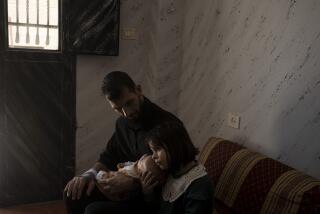Hate-Filled Words Behind a POW’s Gentle Voice
BORAK, Afghanistan — Salahuddin Khalled has a gentle voice, angelic eyes lined thickly with kohl, and is a graduate from a terrorist training camp in Afghanistan. Mention the fact that about 6,500 people are feared dead in the attacks on New York and the Pentagon and his face lights up with a beatific smile.
He set out to fight an Islamic jihad but wound up in a cell with about 40 others in a prison camp perched in the desolate, rocky peaks of northern Afghanistan. Khalled, 27, from Baluchistan province in Pakistan, looks a quiet, learned type, not the sort who would attract suspicion.
But the day he is free, he says, he’ll be ready to go into the world and launch terrorist acts against enemies such as America, as soon as his commander gives the word.
“If he tells me, no problem, I will go,” he said, speaking in slightly awkward English. “When I go for a terrorist action and there is no other way than for me to die, I’ll do it. I’m not afraid of it,” he murmured, seated on a rug in the crowded cell. Cloth bundles, plastic bags, canisters and shoes were suspended from the walls and ceiling like eccentric ornaments.
The CIA has estimated that 50,000 to 70,000 militants have trained as terrorists in Afghanistan in recent years. The training camps would seem obvious targets for U.S. bombs, but by now they are probably abandoned, with nothing more than a few mud shacks remaining.
You could say Khalled is learned but in a frighteningly practical way. He lists the training courses he took at a terrorism camp in Khowst in eastern Afghanistan: terrorism, intelligence, commandos, sabotage, guerrilla operations. He learned how to use weapons and make bombs.
Khalled is a member of the Pakistan-based militant Islamic organization Harkat Moujahedeen, which he said has links with Osama bin Laden, the accused mastermind of the Sept. 11 attacks.
After two years of training and teaching others at the Khowst camp, he went to fight for the Taliban in 1996, helping the radical Islamic movement oust the government of Burhanuddin Rabbani and take over Afghanistan. Within months, Khalled was captured by forces aligned with Rabbani and has been a POW since.
When he speaks of the attacks on New York and the Pentagon, Khalled becomes so elated that he uses terms like “our target” and “we do that action,” as though he had a direct hand in it.
“Maybe a few women and children died in that attack. But our target was operational men and professors and military men. That action was very important for the American government, therefore we do that action.”
A Vow to Resist an American Attack
Despite his pride and visible excitement, he says his own organization probably played no part in the attacks. But he bragged that 400 Harkat Moujahedeen fighters came to aid the Taliban five years ago and claimed that 4,000 are here now, based in Kabul, the capital; Kunduz in the north; and Kandahar in the south--unless they fled to avoid the threat of U.S. bombs.
“America is our enemy, but we can’t fight with America face by face, so we fight a terrorist and a guerrilla war,” Khalled said, trying to justify the use of such tactics against civilians. “If the Americans come to Afghanistan, we will fight them. I go to fight wherever my commander tells me.”
His motive was to help establish a radical Islamic government in Afghanistan, then to spread the movement outward to Central Asia--a development deeply feared in neighboring states such as Uzbekistan and Tajikistan, as well as in Russia.
“We want to make an Islamic government and an Islamic center in Afghanistan. We will fight till this war ends,” Khalled vowed, referring to the civil war between the Taliban and the opposition Northern Alliance. “First we will make Afghanistan an Islamic center, and then if [the militant Islamic movement in] Central Asia wants it, we will help them.”
The POW camp at Borak stands in one of the most desolate, forbidding settings imaginable. Along a tortuous cliff-top track so narrow that two cars cannot pass, there is a medieval scene: prisoners in long flowing garments, bent over double, shouldering heavy logs across narrow metal struts that cross a river to the camp.
Once the logs are hauled for prison fuel, the prisoners squat in formations on the stony riverbank, two guards perched like crows on a rock behind them.
There used to be 2,500 prisoners, but the Northern Alliance swapped most with the Taliban in prisoner exchanges. Now 300 remain, 21 of them foreigners. It’s an exotic mix, with prisoners from Pakistan, Yemen, western China, Myanmar and Iraq.
Abdurrahman, 22, who goes by one name, ran away from his home in Yemen at 17 to fight a jihad, trained at the Khowst camp in 1997 and then went to help the Taliban fight opposition forces. He was captured within three months.
Because of possible links to Bin Laden, he and three other Arab prisoners were moved to punishment cells immediately after the Sept. 11 attacks. He and his Iraqi cellmate, Ala, 23, share a space 7 feet by 4 feet, with barely enough room to stretch out their shackled legs.
Fingering a string of prayer beads and wearing a flashy watch labeled “Watch Cool!” Abdurrahman said he had heard little about Bin Laden before he was captured but is now inspired by him.
“He is an Islamic hero. I haven’t met him, but maybe my leader is connected to him,” he said, naming his commander as Abu Umar.
Of the U.S. attacks, he said, “I think it’s great.” He describes himself as a terrorist and says that if he is freed he will fight alongside the Palestinians.
One of the wildest-looking POWs is a shaggy-haired fellow with white stripes in his long black beard, the kind of man who makes a point of wearing sunglasses indoors.
But Shermalang, 33, regrets fighting on the Taliban side and just wants to go home to his three wives and 33 children in Kabul. He is worried that they will be killed if America bombs the city.
Despite his fearsome appearance, he says all he wants now is peace.
It seems the people to be afraid of in this POW camp are the ones with the innocent eyes.
*
Special correspondent Sergei Loiko contributed to this report.
More to Read
Sign up for Essential California
The most important California stories and recommendations in your inbox every morning.
You may occasionally receive promotional content from the Los Angeles Times.










